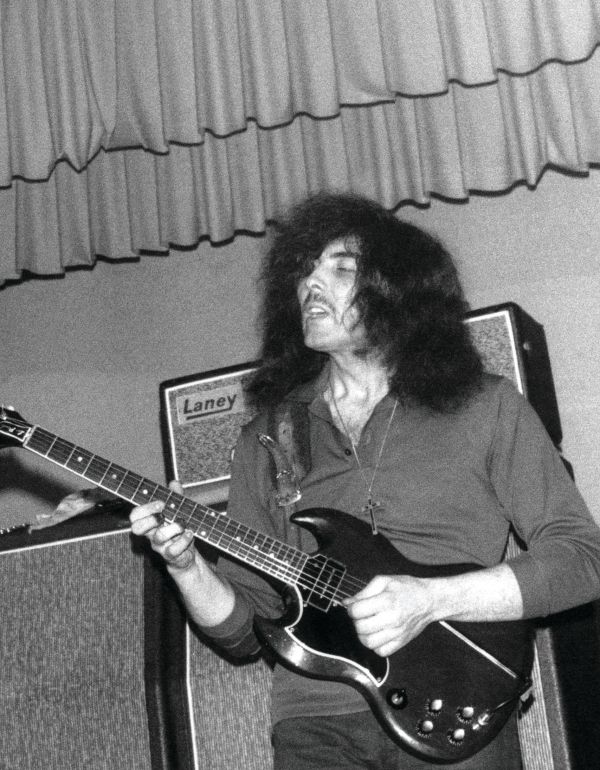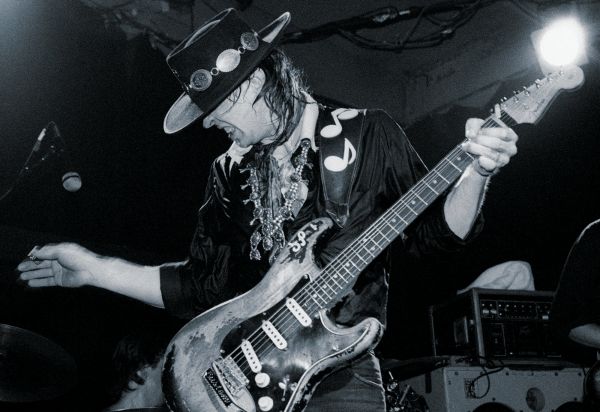Tonal Recall: The Secrets Behind the Extraordinary Guitar Sounds—"Iron Man," "Pride and Joy"

Finding out what gear guitarists use isn’t a problem. Most players will gladly recite a list of their favorite guitars and equipment when asked, especially if they have signature model products. If they won’t, there’s usually a good chance that somebody somewhere has at least snapped a photo or two of their guitars and live rigs.
The bigger challenge is finding out how most guitarists use their gear. It’s not the fault of guitar journalists or the artists themselves—cataloging every single guitar played and amp or effect setting used can be a tedious, laborious, time-intensive affair, and many guitarists can’t remember all of the details (that’s why they pay their guitar techs big bucks). I personally can’t remember every knob on certain amps I own, let alone what my exact favorite settings are.
To help you figure out how to create the guitar tones of several iconic songs, we’ve dug deep into research mode, combing old interviews and meticulously examining stage and studio photos from the appropriate eras. I then dug into my personal gear collection of over 100 guitars, 75 amps and 400 pedals and rack processors to replicate those sounds. If I didn’t have particular pieces of gear, I used items like Fractal Audio’s Axe-Fx II XL+ and AX8 (extremely helpful), a Line 6 POD HD500X and various iPad apps, including Positive Grid’s Bias Series and IK Multimedia’s AmpliTube Series.
Much of the original gear used to record these songs is well known, and as a result many of these items are very expensive, if you can even find them. For those of you with limited funds, we’ve also put together more affordable alternative rigs that should provide most of the core elements of these tones. If you want it all, the most affordable alternative may actually be Fractal’s AX8 and a great guitar or two of your personal preference.
Because control markings and layout styles are inconsistent, I’ve listed all settings from 0–10 where 0 is completely off, 10 is all the way up and 5 is exactly in the middle. Keep in mind that the sound of even the same guitars and amp models can often vary dramatically, especially with vintage gear more than 30 years old. If the recommended settings don’t sound quite right, tweak them as you see fit. These settings worked best with my rigs and should get you very close, but variables such as a guitar’s tone woods and pickups can make a difference. Pedals are listed in the order that they should be chained together in series from the guitar to the amp.
Also keep in mind that all of the examples are studio recordings, so the sounds may not be ideal for live performance. Other important elements like the mics, outboard gear and mixing console settings used in the studio while tracking, mixing and mastering can affect the overall tone, so these sounds may not completely match the final product you hear on a record. However, we hope you’ll find that our settings get you most of the way there and inspire you to come up with your own signature sounds to influence new generations.
“IRON MAN”
Black Sabbath, Paranoid (1970)
Guitarist: Tony Iommi
Get The Pick Newsletter
All the latest guitar news, interviews, lessons, reviews, deals and more, direct to your inbox!
Tony Iommi previously laid the foundation for heavy metal guitar tone on songs like “Black Sabbath” and “N.I.B.” on Black Sabbath’s eponymous debut album, but on the band’s follow-up, Paranoid, he perfected a sound that has inspired every aspiring metal guitarist ever since. On “Iron Man” all of the essential elements of metal guitar are in place—wicked distortion, evil riffing and fleet-fingered soloing, all wrapped up with aggressive attitude and swagger.
Iommi’s “Iron Man” rig was simple—a 1965 Gibson SG Special, modified Dallas-Arbiter Rangemaster treble booster and 100-watt Laney Supergroup MK 1 head with a Laney 4x12 cabinet, most likely loaded with Celestion G12-25M speakers (some Laney cabs from this era had Goodman Audiom 61 speakers).
Iommi plugged into one of the Supergroup’s bass inputs, turned the presence, middle and treble to 10 while the bass was at 0 and cranked the Gain 1 control all the way up to produce crunchy, natural power tube overdrive. In addition to pushing the amp’s input even further into distortion, the Rangemaster cut bass frequencies while working in tandem with the SG’s single-coil P90 bridge pickup to produce thick midrange with a hollow, boxy honk. The guitar was tuned to standard pitch (EADGBE), and Iommi used light-gauge strings (probably .009—.042) and a medium pick.
ORIGINAL GEAR
GUITAR: 1965 Gibson SG Special with P90 pickups (bridge pickup)
AMP: 100-watt Laney Supergroup MK 1 (Presence: 10, Bass: 0, Middle: 10, Treble: 10, Gain One: 10; guitar plugged into Bass input)
CABINET: Laney Supergroup 4x12 with Celestion G12-25M Speakers
PEDAL: Dallas-Arbiter Rangemaster (modified)
STRINGS/TUNING: .009–.042 light-gauge/Standard (EADGBE)
PICK: Medium
- Laney Tony Iommi Signature 15-watt combo
- AXL Guitars USA Bulldog
- Catalinbread Sabbra Cadabra
The Sabbra Cadabra pedal has four controls, while the original Rangemaster effect has only a Set (gain) control. To duplicate the sound of the original Rangemaster, set the Sabbra Cadabra’s controls as follows: Presence: 6, Gain: 4, Vol 4: 3.5, Range: 6.

“PRIDE AND JOY”
Stevie Ray Vaughan and Double Trouble, Texas Flood (1983)
Guitarist: Stevie Ray Vaughan
When Stevie Ray Vaughan and his band Double Trouble went to Los Angeles to record at Jackson Browne’s Down Town Studio, the intention was to record a demo to shop around to various labels. However, producer John Hammond and Epic A&R man Greg Geller were so impressed with the sound and vibe that they decided to release those recordings as Vaughan’s first album, Texas Flood.
These recordings were performed live over two days with no overdubs, providing a good representation of Vaughan’s live sound at the time. While Vaughan played through two Fender Vibroverb amps like he did onstage, only one of the Vibroverbs was miked. A Dumble Dumbleland Special amp that belonged to Browne was also incorporated into his rig because Vaughan loved its tight, big clean tones.
This amp’s 4x12 cabinet was miked as well. Vaughan’s only effects were his Ibanez TS9 Tube Screamer used as a boost for solos and a Roland SDD-320 Dimension D that was added to his solos during mixing, which fattened his tone thanks to its subtle choruslike doubling effect.
ORIGINAL GEAR
GUITAR: 1962/63 Fender Stratocaster “Number One” with rosewood neck, 1959 pickups and left-hand tremolo (middle pickup: intro, verse, chorus, first solo; neck pickup: second solo/outro)
AMPS: 1964 Fender Vibroverb with single JBL D130F 15-inch speaker (Vibrato channel, Input 1, Volume: 6, Treble: 5.5, Middle: 3 Bass: 4, Reverb: off, Vibrato: off), Dumble Dumbleland Special (settings unknown) with Dumble 4x12 with Electro-Voice EVM12L speakers
PEDALS/EFFECTS: Ibanez TS9 Tube Screamer (Drive: 2-3, Tone: 4, Level: 9-10), Roland SDD-320 Dimension D (Mode: 2, used only during mixing)
STRINGS/TUNING: .013 .015 .019p .028 .038 .058. GHS Nickel Rockers/Eb standard (i.e. tuned down half step to Eb Ab Db Gb Bb Eb)
PICK: Fender Heavy, held sideways
GET THE SOUND, CHEAP!
• Fender Standard Stratocaster
• Fender Hot Rod Series Blues Junior III
• Ibanez TS9
TONE TIP
A lot of Stevie Ray’s sound can be attributed to his heavy strings and extremely aggressive attack. No soft touch here—hit the strings hard to get them to sing and sting.
Chris is the co-author of Eruption - Conversations with Eddie Van Halen. He is a 40-year music industry veteran who started at Boardwalk Entertainment (Joan Jett, Night Ranger) and Roland US before becoming a guitar journalist in 1991. He has interviewed more than 600 artists, written more than 1,400 product reviews and contributed to Jeff Beck’s Beck 01: Hot Rods and Rock & Roll and Eric Clapton’s Six String Stories.
“I suppose I felt that I deserved it for the amount of seriousness that I’d put into it. My head was huge!” “Clapton is God” graffiti made him a guitar legend when he was barely 20 – he says he was far from uncomfortable with the adulation at the time
“I was in a frenzy about it being trapped and burnt up. I knew I'd never be able to replace it”: After being pulled from the wreckage of a car crash, John Sykes ran back to his burning vehicle to save his beloved '76 Les Paul










